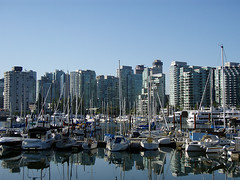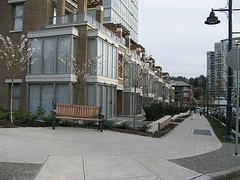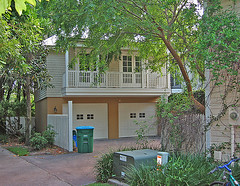Vancouver’s EcoDensity initiative strives to reduce environmental footprint of growth

Posted August 4, 2008 at 1:02PM
I’m getting to be a fan of Canadian land use planning. While Canada has sprawl just as the United States does, my country’s neighbors (or should I say “neighbours”) to the north are less timid about addressing it than most American regions are.
 I’ve already written about the great work in Ontario. Farther west, Vancouver has adopted an “EcoDensity” initiative to engage the city’s residents in planning how to absorb growth while maintaining livability and reducing environmental impacts, including carbon emissions. As the name suggests, much of the conversation has involved how to make more intensive use of land for the environmental benefits, but without sacrificing quality of life.
I’ve already written about the great work in Ontario. Farther west, Vancouver has adopted an “EcoDensity” initiative to engage the city’s residents in planning how to absorb growth while maintaining livability and reducing environmental impacts, including carbon emissions. As the name suggests, much of the conversation has involved how to make more intensive use of land for the environmental benefits, but without sacrificing quality of life.
The discussion has been under way for two years, and earlier this summer the city council unanimously approved the basic principles. It also approved two immediate actions: new construction that involves rezoning must include green buildings that meet LEED silver standards or better; and development of two acres or more must include a range of housing types and tenures (no more cookie-cutter development) to further affordability and meet additional sustainability standards.
 Under the leadership of former planning director Larry Beasley and current director Brent Toderian, Vancouver has already made progress toward sustainability using EcoDensity principles. The initiative’s web site reports:
Under the leadership of former planning director Larry Beasley and current director Brent Toderian, Vancouver has already made progress toward sustainability using EcoDensity principles. The initiative’s web site reports:
“Although the city has been growing, there are fewer vehicles entering the city than there were 10 years ago, and average distances being driven by Vancouver registered passenger vehicles were down almost 30% between 1993 and 2002. When density is well-located close to shopping areas and community amenities, more people can travel without a car to obtain goods and services. These non-work trips are the fastest growing types of trips. And, while not everyone can live close to their work, locating more housing close to transit increases the number of work trips that are not by car.”
Not all Vancouver residents are on board. Toderian acknowledges that some fear giveaways to developers and more high-rise towers without any additional amenities. [I think, to an extent, that skepticism is healthy. Sustainability should not only mean high-rises, whether in Vancouver or elsewhere, and it absolutely must be accompanied by parks and neighborhood amenities to help make density livable.] But a lot of the city is on board, at least in principle, and wants to help shape the vision.
 One of the features of Vancouver planning that I especially like is what Toderian calls “gentle, hidden or invisible density" such as row houses, basement suites, or units in alleys (“lanes” in Canadian vocabulary) such as coach houses or rental units above garages (see photo from a development in Florida), that maintain a neighborhood’s existing scale. This approach is slated for priority attention by the city council, along with removing any barriers to green building and updating zoning.
One of the features of Vancouver planning that I especially like is what Toderian calls “gentle, hidden or invisible density" such as row houses, basement suites, or units in alleys (“lanes” in Canadian vocabulary) such as coach houses or rental units above garages (see photo from a development in Florida), that maintain a neighborhood’s existing scale. This approach is slated for priority attention by the city council, along with removing any barriers to green building and updating zoning. There is a lot of great information on the concept, the discussion, and the city’s progress on its EcoDensity web site.